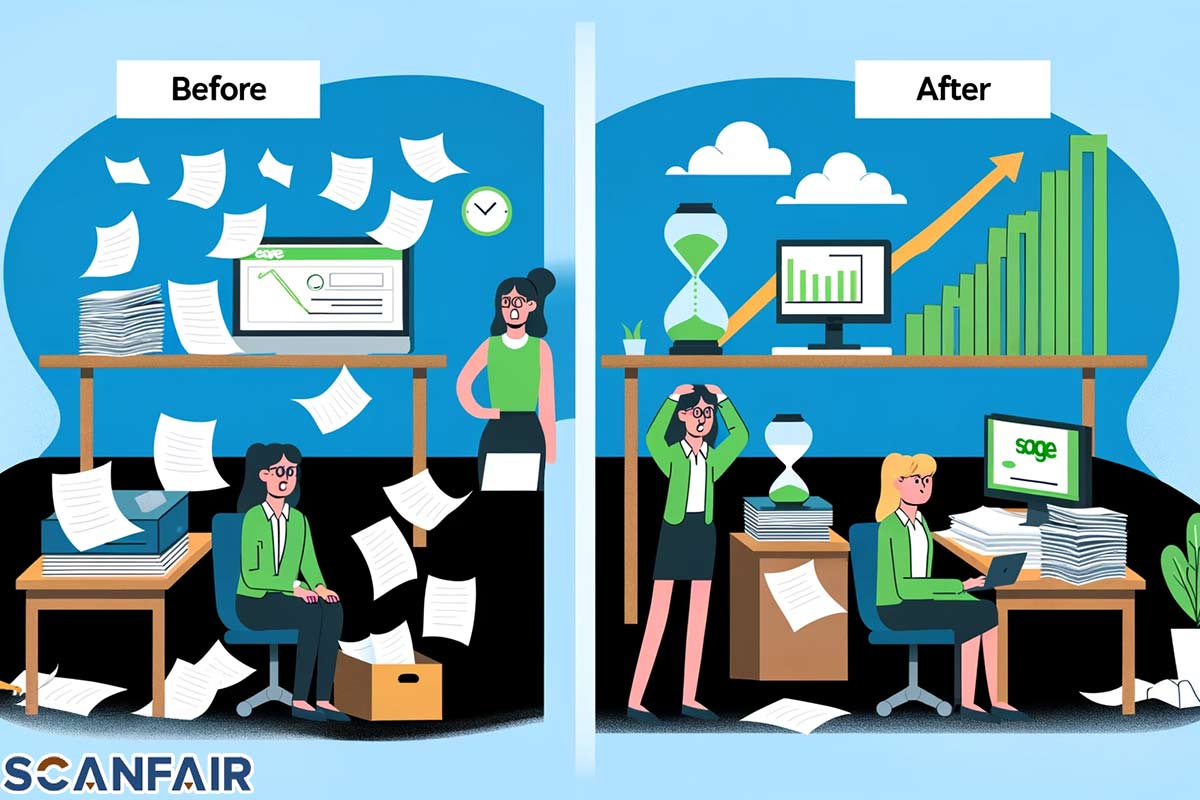In enterprise resource planning (ERP) solutions, Sage 100 and Sage 300 emerge as pivotal tools for businesses aiming to optimize their operational efficiency, financial management, and customer relations. Designed to cater to the varying needs of small to mid-sized and larger enterprises, these platforms offer a comprehensive suite of modules covering accounting, inventory, operations, distribution, and more. Sage 100, formerly MAS 90 and MAS 200, is ideal for small to mid-sized businesses seeking a scalable solution that grows with them. It emphasizes ease of use, flexibility, and efficiency in managing core business processes. On the other hand, Sage 300, previously known as Accpac, targets mid-sized to large enterprises focusing on supporting global operations through advanced features such as multi-currency support, comprehensive financial consolidation, and extensive customization capabilities. Both solutions aim to provide businesses with the tools to streamline operations, enhance decision-making, and drive growth in a competitive marketplace. In the essay, we at Scan Fair will talk more about this topic.
Sage 100: Boosting SMB Operations
Sage 100 stands out for small to mid-sized businesses with its comprehensive suite to enhance efficiency and productivity. Key features include:
- Advanced financial management.
- Simplifying complex accounting tasks.
- Robust inventory management.
- Optimizing stock levels and fulfillment.
Its CRM functionality boosts customer engagement and sales, while customizable reporting tools aid in strategic decision-making. Designed for scalability, Sage 100 grows with your business, ensuring you only pay for what you need. This ERP solution supports various industries, offering specialized functionalities catering to unique business requirements.
Detailed Exploration of Sage 100’s Core Functionalities
Sage 100 offers in-depth financial management with tools for streamlined accounting, budgeting, and cash flow analysis. Its inventory management system enhances supply chain operations with tracking, ordering, and distribution features. The CRM module improves customer relationships and sales management. Sage 100’s customizable reporting and business intelligence capabilities also enable data-driven decisions, vital for business growth and efficiency.
Sage 100: Meeting SMB Unique Needs
Sage 100 is uniquely designed for small to mid-sized businesses, offering flexibility, scalability, and cost-effectiveness. Its modular structure allows businesses to tailor the solution to their needs, avoiding unnecessary expenses. The platform’s user-friendly interface ensures easy adoption and minimizes training requirements. Sage 100 also provides cloud and on-premise deployment options, accommodating various IT preferences and infrastructure needs. This adaptability makes it an ideal solution for businesses seeking to enhance operational efficiency and foster growth.
Key Features of Sage 300: Powering Global Business Management
Sage 300 is designed for global business management, offering robust features that cater to the complex needs of international operations. Its core functionalities include advanced financial reporting, inventory and supply chain management, and multi-currency support, crucial for businesses operating across multiple countries. Sage 300 enhances operational efficiency with its comprehensive project and vendor management modules, facilitating seamless global transactions and compliance with local tax regulations. Its scalability and customization options allow businesses to tailor the software to their needs, supporting growth and adaptation in the dynamic global market.
Comprehensive Analysis of Sage 300’s Advanced Features
Sage 300 stands out with its advanced financial management, inventory control, and global operations support features. It offers real-time financial consolidation, multi-currency transaction capabilities, and detailed inventory tracking to ensure efficient global supply chain management. Customizable reporting tools and analytics provide valuable insights for strategic decision-making. Its flexible architecture supports various integrations and add-ons, making it a versatile solution for businesses aiming to optimize their global operations.
Suitability of Sage 300 for Managing Operations on a Global Scale
Sage 300 is ideally suited for businesses managing operations on a global scale, thanks to its comprehensive multi-currency support, compliance features, and scalability. It simplifies managing finances, inventory, and vendor relations across borders, ensuring compliance with international tax laws and accounting standards. The platform’s support for multiple languages and customizable nature allows for tailored solutions that fit the unique needs of a global business landscape, making Sage 300 a preferred choice for companies looking to expand their operations internationally while maintaining operational efficiency and compliance.
Sage 100 vs Sage 300: A Comparative Analysis
When comparing Sage 100 and Sage 300, it’s crucial to understand that both serve distinct business needs despite their shared lineage. Sage 100 is tailored for small to mid-sized businesses seeking an integrated ERP solution to streamline operations, enhance financial management, and improve inventory control. It offers a modular approach, allowing businesses to add functionalities as they grow. On the other hand, Sage 300 is designed for small to medium enterprises looking to expand their operations globally. It includes advanced features for multi-currency transactions, comprehensive financial consolidation across multiple business units, and robust inventory and project management. Sage 300 stands out for its global business management capabilities, including compliance with international accounting standards, making it the go-to for companies with or aspiring for a global footprint.
Side-by-Side Comparison of Features, Scalability, and Usability
Sage 100 shines with its user-friendly interface, making it accessible for businesses without a dedicated IT department. Its scalability is centered around a modular design, enabling companies to customize solutions based on current needs with scale-up options. Sage 300, however, offers broader scalability for growing businesses, particularly those with international operations. Its features encompass more extensive financial management tools, multi-currency support, and compliance capabilities, which are crucial for businesses operating in multiple countries. Usability-wise, Sage 300 is designed for companies with a more complex operational structure, requiring a more detailed setup but offering more comprehensive global business management tools.
Graphical Representations to Illustrate Differences
For graphical representations, envision a side-by-side comparison chart highlighting key differences. For Sage 100, icons could depict its modular structure, emphasizing the ease of adding functionalities. For Sage 300, graphics would focus on its global capabilities, like multi-currency support and international compliance. Another visual could compare scalability, showing Sage 100’s linear growth path versus Sage 300’s expansive global scaling options. Usability could be illustrated through user interface screenshots, showcasing Sage 100’s simplicity and Sage 300’s detailed, feature-rich environment. These visuals effectively convey the distinct advantages of each system, aiding businesses in choosing the solution that best fits their needs.
Sage & E-commerce Integration
Sage 100 and Sage 300 offer robust integration capabilities with Amazon and other e-commerce platforms, enabling businesses to streamline their online sales operations. These integrations allow for seamless data synchronization across systems, improving efficiency in inventory management, order processing, and financial tracking. By connecting Sage software with e-commerce platforms, businesses can automate sales data transfer, update inventory levels in real time, and ensure accurate financial reporting. This connectivity saves time and reduces the risk of manual errors, providing a more reliable and efficient operation system for e-commerce businesses.
Sage 100 & 300: Amazon Integration
Sage 100 and Sage 300 integrate with Amazon and significant e-commerce platforms through third-party connectors and built-in APIs, facilitating the automatic data exchange between systems. These integrations enable businesses to manage their e-commerce operations directly from their Sage software, including product listings, order fulfillment, and customer data management. For example, when a sale is made on Amazon, the order details are automatically imported into Sage, triggering inventory adjustments and financial entries. This seamless integration streamlines operations enhance customer satisfaction with timely order processing and provides accurate financial insights.
Integration: Inventory & Finance Benefits
Integrating Sage 100 and Sage 300 with e-commerce platforms significantly benefits inventory management, order processing, and financial tracking. Businesses can maintain accurate inventory levels, automatically updating stock quantities across all sales channels to prevent overselling and stockouts. Order processing becomes more efficient, with automatic order importation reducing manual entry and speeding up fulfillment times. Financial tracking is also enhanced, as sales data is directly integrated into the accounting modules of Sage, providing real-time insights into revenue, expenses, and profitability. This integration simplifies the complexities of managing e-commerce operations, allowing businesses to focus on growth and customer service.
Pricing and Investment Consideration
Understanding their pricing structures is crucial for informed decision-making when considering Sage 100 and Sage 300 for business operations. Both solutions offer various pricing tiers, dependent on the number of users, modules selected, and deployment options (cloud vs. on-premise). Sage 100 is typically positioned for smaller businesses with a more straightforward pricing model, making it an accessible starting point for those new to ERP systems. Sage 300, catering to companies with more complex needs, including global operations, often comes at a higher cost, reflecting its advanced features and scalability. Businesses need to assess their specific needs against the functionality offered by each tier to determine the most cost-effective solution.
Breakdown of Pricing Structures for Sage 100 and Sage 300
Sage 100’s pricing structure is designed with small to mid-sized businesses in mind, offering a modular approach where companies can select and pay for only the features they need. This flexibility helps control costs while allowing for scalability as business requirements grow. Sage 300, on the other hand, targets businesses with more complex needs, offering a comprehensive suite of features that support global operations, including advanced financial management and multi-currency support. Its pricing reflects the broader scope of functionality and scalability, with costs varying significantly based on the deployment method, number of users, and selected modules.
Understanding the ROI for Businesses Operating on Amazon
For businesses operating on Amazon and considering Sage 100 or Sage 300, the return on investment (ROI) is critical. Integrating Sage solutions can improve operational efficiency, reduce manual errors, and enhance decision-making through better financial insights. For e-commerce businesses, this translates into better inventory management, streamlined order processing, and improved customer satisfaction, leading to increased sales and profitability. The initial investment in Sage software can be justified by the long-term savings and revenue growth it facilitates. Businesses should conduct a thorough cost-benefit analysis, considering the specific efficiencies and improvements the software can bring to their operations, to assess the potential ROI accurately.
User Experiences and Case Studies
User experiences and case studies offer invaluable insights into the real-world application and benefits of Sage 100 and Sage 300. Businesses considering these ERP solutions can understand the tangible impacts on operations, efficiency, and growth through testimonials and detailed analyses. These narratives often highlight Sage products’ flexibility, scalability, and comprehensive feature sets, illustrating how they cater to diverse industry needs. By examining these real-life examples, companies can better gauge how Sage 100 or Sage 300 could be leveraged to meet their specific operational goals and challenges.
User Feedback on Sage 100 & 300
Testimonials from businesses using Sage 100 and Sage 300 consistently praise the software for its robust functionality and adaptability. Users note significant improvements in financial management, inventory control, and customer relationship management. Many underscore the ease of use and intuitive interface of Sage 100, making it an ideal choice for smaller businesses or those transitioning to an ERP system for the first time. Sage 300 users often highlight the platform’s ability to support complex, global operations with features like multi-currency support and comprehensive compliance tools, which are essential for expanding businesses in international markets.
Efficiency & Growth: Sage Case Studies
Sage 100 and Sage 300 case studies demonstrate their impact on enhancing operational efficiency, fostering growth, and ensuring scalability. For instance, a manufacturing company might report streamlined production processes and reduced lead times after implementing Sage 100. At the same time, a multinational distributor could showcase how Sage 300 facilitated its expansion into new markets with efficient multi-currency transactions and compliance management. These studies often reveal significant ROI, with businesses experiencing improved inventory accuracy, enhanced customer satisfaction, and increased sales. By illustrating specific scenarios where Sage products have driven business success, these case studies provide compelling evidence of the value Sage ERP solutions can offer.
Technical Support and Community Resources
Sage 100 and Sage 300 users have access to a robust support infrastructure designed to ensure smooth operation and maximize the value of their ERP solutions. This support system encompasses direct technical assistance, extensive online resources, and a vibrant community forum. Sage’s commitment to user support is evident in its comprehensive approach, offering various channels to assist users with technical issues, system optimization, and ongoing education. By leveraging these resources, businesses can resolve immediate technical challenges and gain deeper insights into leveraging their Sage software to its fullest potential.
Sage 100 & 300 Support Overview
Sage provides a multi-tiered support infrastructure for Sage 100 and Sage 300 users, including dedicated customer service teams, technical support specialists, and a wealth of online resources. Users can access personalized assistance through phone, email, or live chat, ensuring that help is readily available whenever needed. Additionally, Sage offers a comprehensive online knowledge base featuring how-to guides, troubleshooting articles, and software updates. This blend of direct support and self-help resources empowers users to address issues efficiently and enhance their understanding of the software.
Sage: Forums, Training & Support
The Sage community forums are precious, allowing users to share experiences, solutions, and best practices. Sage experts moderate these forums and offer a collaborative environment for users to learn from one another. Beyond the forums, Sage offers extensive training resources, including webinars, e-learning courses, and in-person workshops, designed to help users maximize the utility of their ERP solutions. Community engagement, educational opportunities, and diverse customer service options ensure that Sage 100 and Sage 300 users have comprehensive support at every stage of their software journey.
Making the Right Choice for Your Business
Choosing between Sage 100 and Sage 300 is a significant decision that can impact the efficiency and scalability of your business operations. Both platforms offer robust features tailored to different business sizes and needs, making it crucial to consider various factors before choosing. Understanding the specific requirements of your business, including the scale of your operations, your growth ambitions, and the complexity of your financial and inventory management needs, will guide you toward the most suitable solution.
Factors to Consider When Choosing Between Sage 100 and Sage 300
When deliberating between Sage 100 and Sage 300, key considerations include:
- The size and complexity of your business.
- The scope of your operational needs.
- Your budget.
Sage 100 is often favored by small to mid-sized businesses looking for a comprehensive yet straightforward solution for managing their core financials and operations. In contrast, Sage 300 is designed for mid-sized to larger businesses that require advanced features, such as multi-currency support and more sophisticated inventory and project management capabilities. Assessing your current and future needs regarding functionality, scalability, and global operations support is essential.
Custom Sage Solutions for Amazon Biz
Integration capabilities with these systems are paramount for businesses operating on Amazon or other e-commerce platforms. Both Sage 100 and Sage 300 offer integration solutions, but the choice depends on the volume of transactions, the geographical spread of your operations, and the complexity of your inventory management needs. Sage 100 can efficiently handle smaller, more localized operations. At the same time, Sage 300 is better suited for businesses with a global customer base and a need for real-time multi-currency and tax compliance features. Considering these aspects will help tailor the solution to fit the specific needs of your Amazon-related business, ensuring smooth operations and scalability.
Conclusion
Selecting the right ERP system, whether Sage 100 or Sage 300, is pivotal for enhancing operational efficiency, achieving growth, and maintaining competitiveness in the digital age. Both platforms offer unique sets of features tailored to meet the diverse needs of businesses, from minor to mid-sized operations to global enterprises. Sage 100 is ideal for companies seeking scalability within a modular framework, while Sage 300 caters to businesses requiring comprehensive global management capabilities. Ultimately, the decision should align with your business objectives, operational complexity, and future growth aspirations. Leveraging the insights from user experiences, support resources, and integration capabilities will ensure your investment in Sage software propels your business toward its strategic goals.




